2013版初中英语全程复习方略课件(专题突破案)专题一 听力(译林牛津版)
文档属性
| 名称 | 2013版初中英语全程复习方略课件(专题突破案)专题一 听力(译林牛津版) |
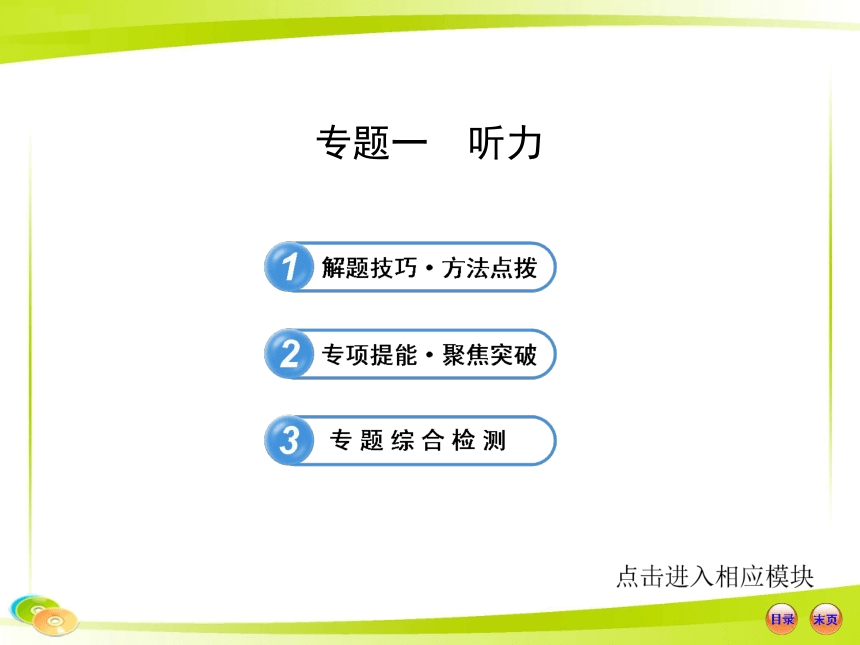
|
|
| 格式 | zip | ||
| 文件大小 | 1.1MB | ||
| 资源类型 | 教案 | ||
| 版本资源 | 牛津译林版 | ||
| 科目 | 英语 | ||
| 更新时间 | 2014-02-27 08:09:58 | ||
图片预览

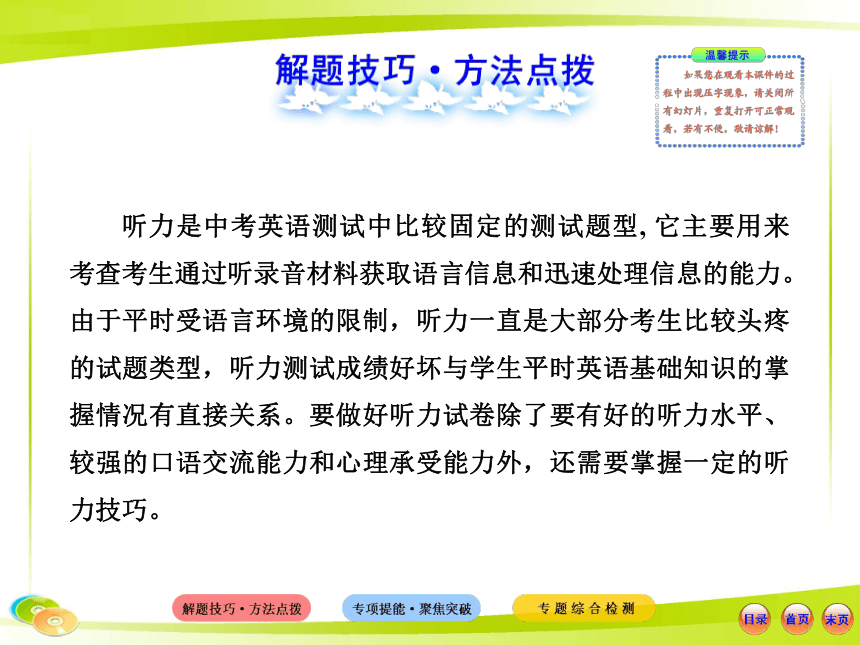
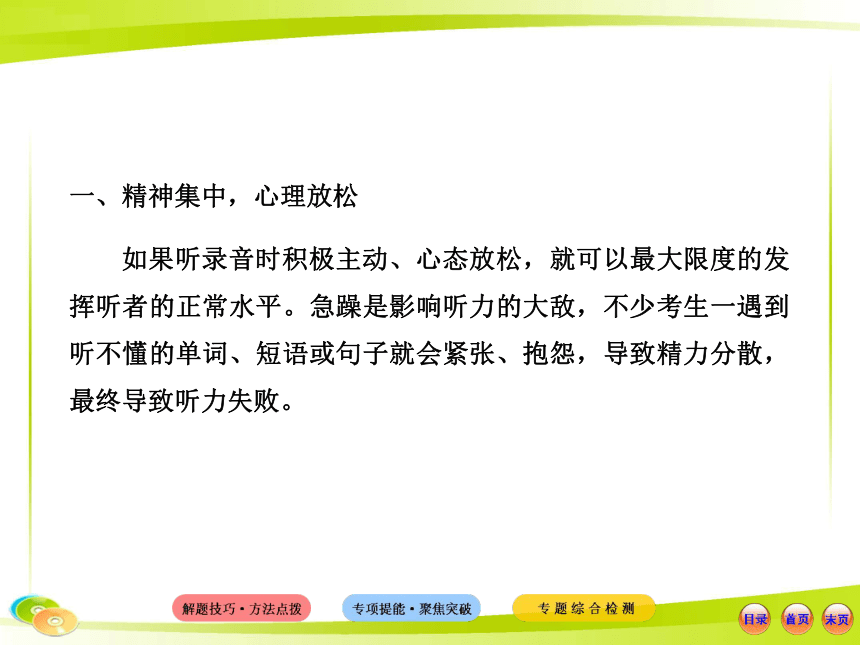
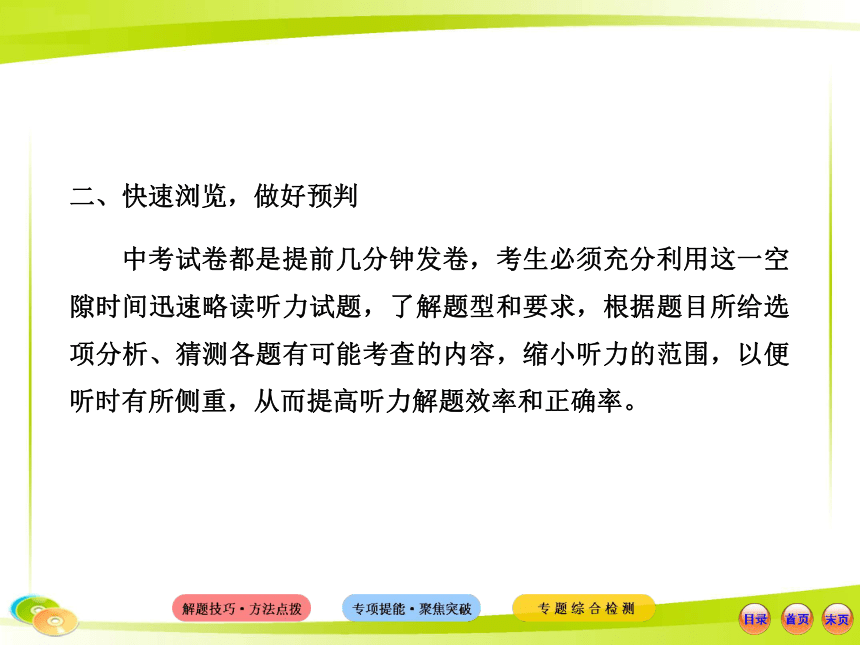
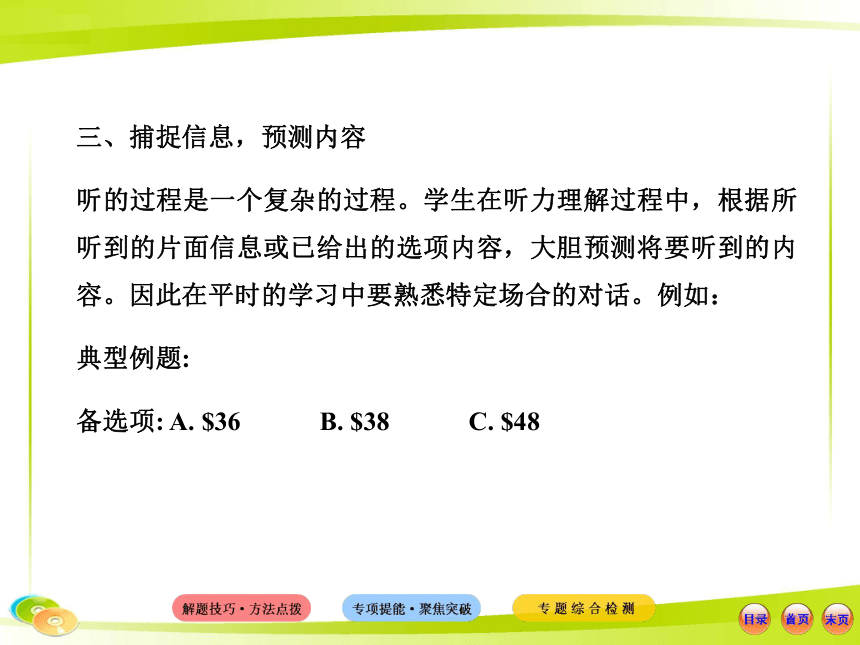
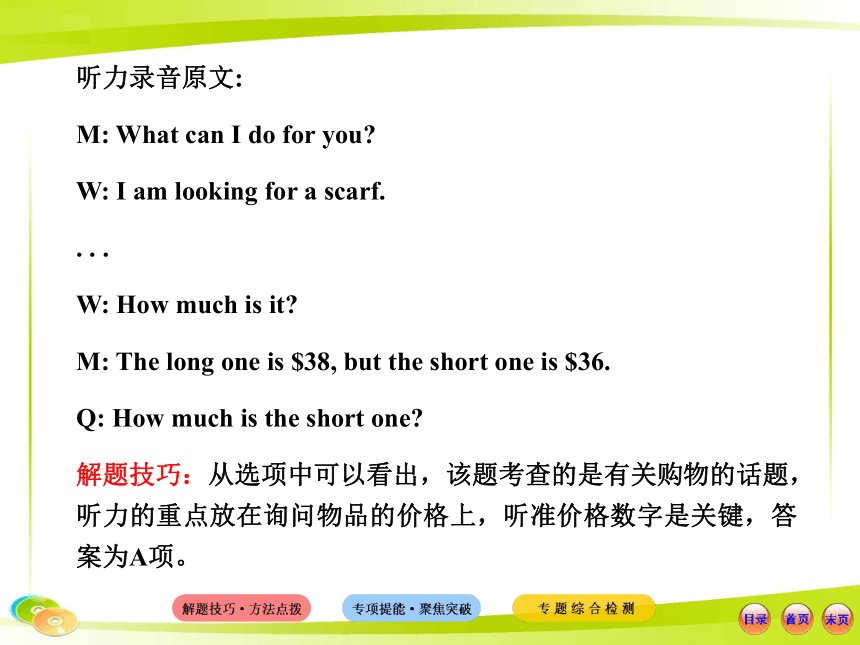
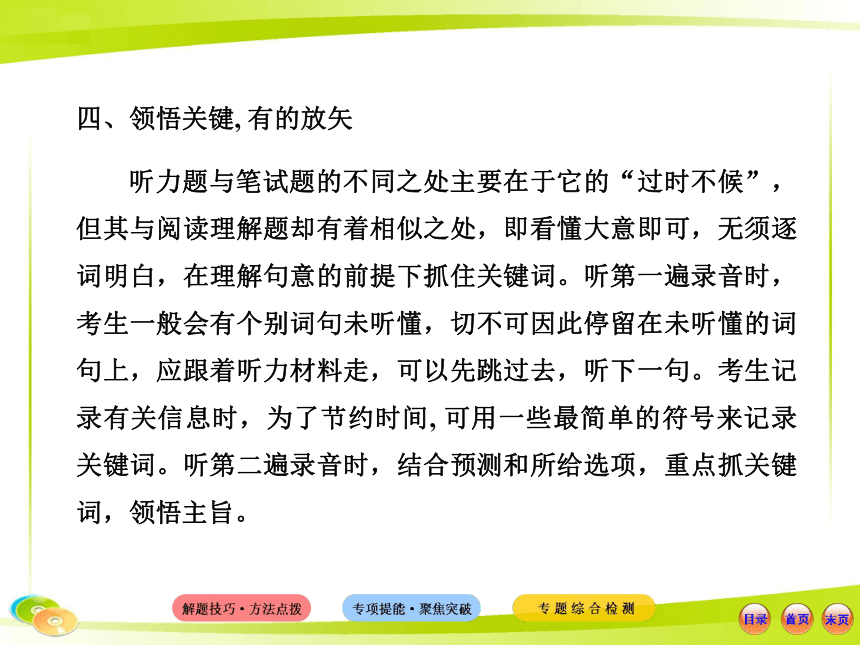
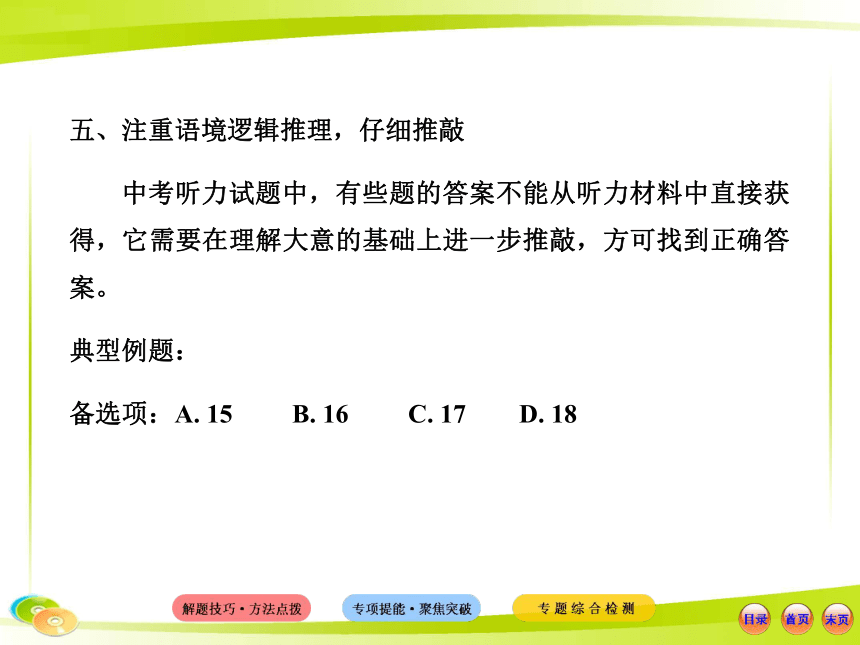

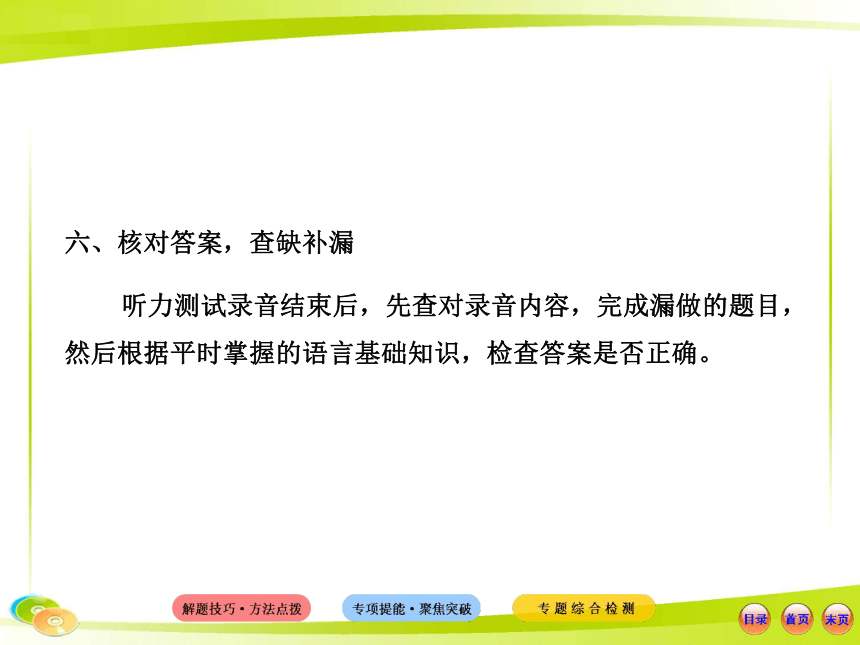
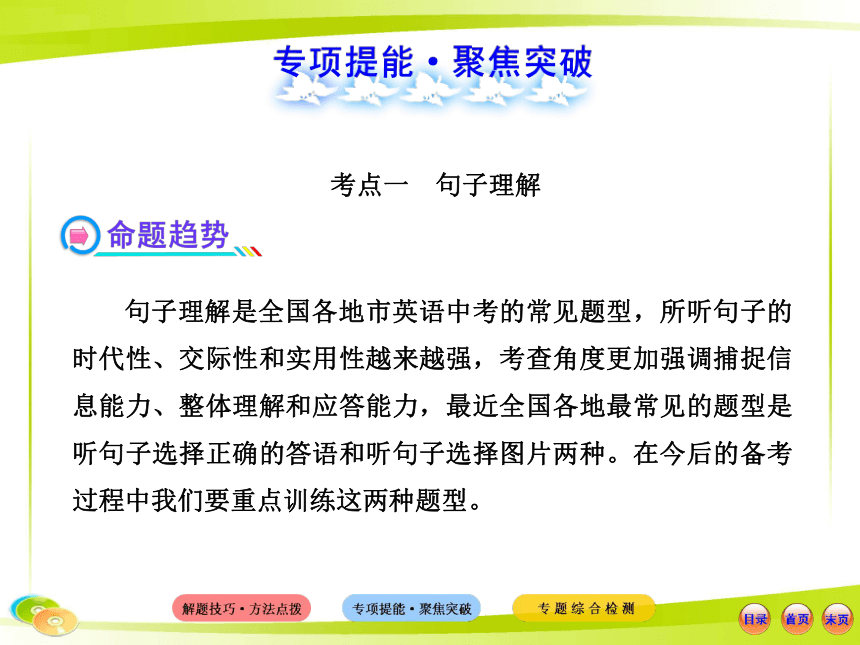
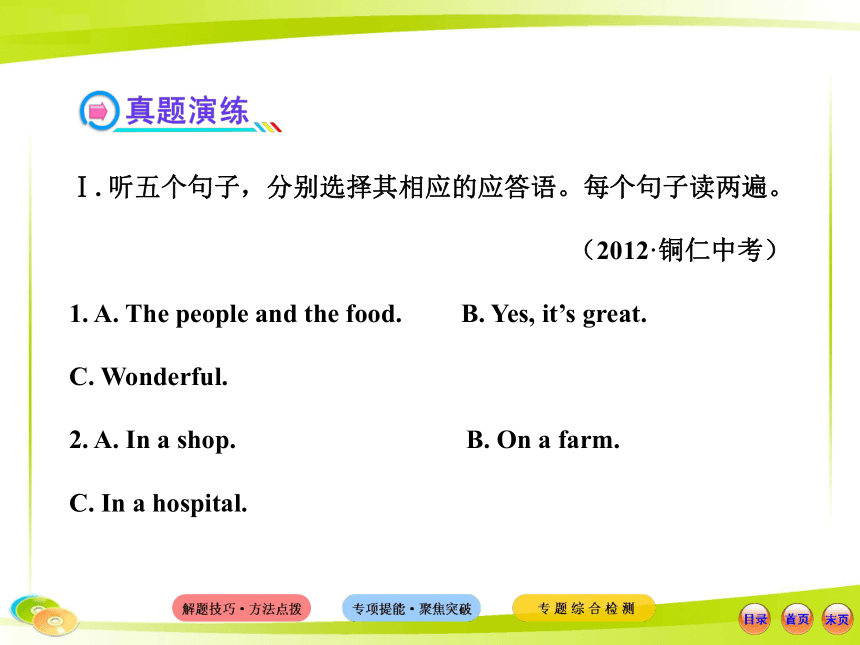
文档简介
课件58张PPT。专题一 听力 听力是中考英语测试中比较固定的测试题型, 它主要用来考查考生通过听录音材料获取语言信息和迅速处理信息的能力。由于平时受语言环境的限制,听力一直是大部分考生比较头疼的试题类型,听力测试成绩好坏与学生平时英语基础知识的掌握情况有直接关系。要做好听力试卷除了要有好的听力水平、较强的口语交流能力和心理承受能力外,还需要掌握一定的听力技巧。一、精神集中,心理放松
如果听录音时积极主动、心态放松,就可以最大限度的发挥听者的正常水平。急躁是影响听力的大敌,不少考生一遇到听不懂的单词、短语或句子就会紧张、抱怨,导致精力分散,最终导致听力失败。二、快速浏览,做好预判
中考试卷都是提前几分钟发卷,考生必须充分利用这一空隙时间迅速略读听力试题,了解题型和要求,根据题目所给选项分析、猜测各题有可能考查的内容,缩小听力的范围,以便听时有所侧重,从而提高听力解题效率和正确率。三、捕捉信息,预测内容
听的过程是一个复杂的过程。学生在听力理解过程中,根据所听到的片面信息或已给出的选项内容,大胆预测将要听到的内容。因此在平时的学习中要熟悉特定场合的对话。例如:
典型例题:
备选项: A. $36 B. $38 C. $48听力录音原文:
M: What can I do for you?
W: I am looking for a scarf.
. . .
W: How much is it?
M: The long one is $38, but the short one is $36.
Q: How much is the short one?
解题技巧:从选项中可以看出,该题考查的是有关购物的话题, 听力的重点放在询问物品的价格上,听准价格数字是关键,答案为A项。四、领悟关键, 有的放矢
听力题与笔试题的不同之处主要在于它的“过时不候”,但其与阅读理解题却有着相似之处,即看懂大意即可,无须逐词明白,在理解句意的前提下抓住关键词。听第一遍录音时,考生一般会有个别词句未听懂,切不可因此停留在未听懂的词句上,应跟着听力材料走,可以先跳过去,听下一句。考生记录有关信息时,为了节约时间, 可用一些最简单的符号来记录关键词。听第二遍录音时,结合预测和所给选项,重点抓关键词,领悟主旨。五、注重语境逻辑推理,仔细推敲
中考听力试题中,有些题的答案不能从听力材料中直接获得,它需要在理解大意的基础上进一步推敲,方可找到正确答案。
典型例题:
备选项:A. 15 B. 16 C. 17 D. 18听力录音原文:
M: How old are you, Mary?
W: My sister is 14 years old, I am two years older than her.
Q: How old is Mary?
解题技巧:只听到“14 years old”是不对的,听到的只是片面信息,需要进一步推敲。根据句子I am two years older than her可知Mary是16岁了,因此答案为B项。六、核对答案,查缺补漏
听力测试录音结束后,先查对录音内容,完成漏做的题目,然后根据平时掌握的语言基础知识,检查答案是否正确。 考点一 句子理解
句子理解是全国各地市英语中考的常见题型,所听句子的时代性、交际性和实用性越来越强,考查角度更加强调捕捉信息能力、整体理解和应答能力,最近全国各地最常见的题型是听句子选择正确的答语和听句子选择图片两种。在今后的备考过程中我们要重点训练这两种题型。Ⅰ. 听五个句子,分别选择其相应的应答语。每个句子读两遍。
(2012·铜仁中考)
1. A. The people and the food. B. Yes, it’s great.
C. Wonderful.
2. A. In a shop. B. On a farm.
C. In a hospital. 3. A. Yes, it’s nice for a walk.
B. I’ve just listened to the weather report.
C. Yes, I am very well today.
4. A. Welcome.
B. Thank you all the same.
C. Thank you, sir.
5. A. That’s good. B. That’s terrible.
C. Good idea. 听力原文:
1. How do you like China?
2. Where does a doctor work?
3. It’s a fine day, isn’t it?
4. Welcome to beautiful Tongren.
5. Lots of fish have died in this river because it’s too dirty. 角度剖析:
本题是2012年铜仁中考听力第Ⅱ题,从总体上分析这五个句子考查的是日常交际用语。第1题询问的是对某物的看法;第2题询问的是地点;第3题考查的是反意疑问句;第4题考查的是表达感谢;第5题考查的是表示遗憾或不满的交际用语。答案分析:
1. 【解析】选C。How do you like China? 意为“你觉得中国怎么样”,故C项适合作答。
2. 【解析】选C。由问句可知询问的是医生工作的地点,故选C。
3. 【解析】选A。由句子可知谈到的是天气状况,故A项适合作答。
4. 【解析】选C。对对方的欢迎应该表示感谢。
5. 【解析】选B。由所听句子是不好的消息可知答案为B项。Ⅱ. 听句子,选出与所听句子内容相匹配的图画。
(2011·哈尔滨中考)听力原文:
1. Peter was practicing the guitar when it rained heavily outside.
2. Many children like this little elephant because it’s very cute.
3. The radio says it’s going to be sunny tomorrow.
4. Eating fruits every day is good for your health.
5. These two boys are running in the 100-meter race. 角度剖析:本题是2011年哈尔滨中考听力部分第一题,五个小题分别涉及日常活动、个人喜好、天气状况、饮食健康和体育活动五个项目。主要考查学生对不同乐器及动物名称、不同天气状况、不同食品和运动名称的辨音区分。答案分析:
1. 【解析】选A。由听力录音中“guitar”一词可确定A图与之相符,同时也要注意到B、C两图在初中英语阶段极少涉及它们的英语表述。
2. 【解析】选B。由录音中“elephant”一词可知B图与之相符,A图“bear”、C图“pig”明显在发音长度上较“elephant”短许多。
3. 【解析】选A。由录音中“sunny”一词可知图A与之相符,天气话题也是各地英语中考最常见话题之一。4. 【解析】选B。由录音中“eating fruits”可知B图与之相符,A图中“花”极少与“eat”相关,C图中“玉米”也很少与饮食健康相联系,联系最多的就是水果(fruits)和蔬菜(vegetables)。
5. 【解析】选A。由录音中“two boys”及“running”可知A图与之相符,听力测试中一定要注意人物身份、性别及活动的对应。 考点二 小对话理解
近几年小对话理解题是全国各地市英语中考的最常见题型之一,命题方式主要有两种,第一种是听对话回答问题,第二种是听对话选择图片。预计2013年在全国各地英语听力题型中该题型仍然会占听力题的很大比重。Ⅰ. 听小对话,根据你听到的内容从每小题的三个选项中选出一个正确答案,每段对话听两遍。
(2012·荆州中考)
1. What does Mr. Black do?
A. He is a worker.
B. He is a shop assistant.
C. He is a teacher. 2. Where are they talking?
A. In a school.
B. In a hotel.
C. In a shop.
3. Where does the woman come from?
A. Canada. B. England. C. France. 4. What does the man want to be now?
A. A scientist. B. A teacher. C. A doctor.
5. What does Miss Black ask the boy to do?
A. To read more books.
B. Not to read in class.
C. To read good books. 听力原文:
1. W: What do you do, Mr. Black?
M: I teach math in No. 2 Middle School.
2. W: We’d like to have a single room with a bathroom.
M: OK. How long will you stay here?
3. M: You speak good English. Are you from America?
W: No. I’m from France. But I stayed in Canada for a few years. 4. W: What do you want to be in the future?
M: When I was a little boy, I wanted to be a doctor. But now I want to be a scientist. What about you?
W: I’d like to be a teacher.
5. W: What are you doing, Tom?
M: I. . . I’m reading a book, Miss Black.
W: Oh, it’s a good book. But you’d better read it after class.
M: I’m sorry, Miss Black. 角度剖析:
分析这五组对话所提出的问题可知第1个问题询问的是布莱克先生的职业,第2个问题询问的是谈话的地点,第3个问题询问的是这位女士来自哪里,第4个问题询问的是这名男士现在想成为什么,第5个问题询问的是布莱克小姐想让这个男孩干什么。答案分析:
1. 【解析】选C。本题非常容易选出正确答案,其关键词为teach和school。
2. 【解析】选B。由说话人想要一个有浴室的单人间可知谈话的地点是旅馆。
3. 【解析】选C。本题设置的干扰因素比较多,关键点是转折连词but前的I’m from France. 。4. 【解析】选A。本题难度较大,关键句是But now I want to be a scientist。故选A。
5. 【解析】选B。由句子But you’d better read it after class. 可知Miss Black不让Tom在课堂上读那本书,故选B。Ⅱ. Choose the right picture according to what you hear.
(2011·齐齐哈尔中考)1. _______ 2. _______ 3. _______ 4. _______ 5. _______No. 1.
M: Do you often watch sport games on TV?
W: Yes. I like tennis best. And you?
M: I enjoy watching ping-pong games.
Q: What sport does the man like? No. 2.
W: Hi, Tom. Is your sister at home?
M: No, she isn’t. My mother is in hospital, so she has to look after her.
W: I’m sorry to hear that.
Q: Where is Tom’s sister now? No. 3.
M: Mary, shall we go hiking tomorrow?
W: Great! But the radio says it will be rainy tomorrow.
M: What a pity!
Q: How is the weather tomorrow? No. 4.
M: Jane, when is our English exam?
W: On Friday.
M: My God! We’ll have a science report that day.
Q: When is the English exam? No. 5.
M: Are you free this afternoon?
W: Sorry, I’ll have a swimming lesson, but I’m free tomorrow afternoon.
M: Wonderful! Let’s go to the park tomorrow.
W: OK!
Q: What’s the girl going to do this afternoon? 角度剖析:分析这6幅图片可知第1幅画是游泳,第2幅画是网球,第3幅画是乒乓球,第4幅画是雨天,第5幅画是日期,第6幅画是医院。
答案分析:
1. 【解析】选C。本题具有很强的迷惑性,这个女的喜欢网球节目,但是男的喜欢看乒乓球节目,而问题问的是男的喜欢什么运动,故选C。
2. 【解析】选F。本题的关键句子是My mother is in hospital, she has to look after her. , 故选F。3. 【解析】选D。本题的关键句子是Great! But the radio says it will be rainy tomorrow. ,故选D。
4. 【解析】选E。本题的关键信息On Friday。
5. 【解析】选A。本句关键信息是I’ll have a swimming lesson,故选A。考点三 长对话理解
长对话理解是全国各地市英语中考听力的常见题型,近几年逐渐成为热门题型,在2013年的中考中仍然是主要题型之一。录音中有一段对话和5个问题,听对话和问题两遍后,从每小题A、B、C三个选项中选出能回答录音中每个问题的正确答案。
(2011·菏泽中考)
1. Where is Mary from?
A. Australia. B. America. C. Canada. 2. Where do Mary’s grandparents live?
A. In the countryside.
B. In a big city.
C. In a small town near the city.
3. What are Li Lei’s family going to do in the summer?
A. They’re going to stay at home.
B. They’re going to visit Li Lei’s grandparents.
C. They’re going to take a trip to the south. 4. How many cities is Li Lei going to visit?
A. Two. B. Three. C. Four.
5. What are the boy and the girl mainly talking about?
A. Their holiday plans.
B. Their school life.
C. The places of great interest. 听力原文:
Li Lei: Summer holiday will begin next month. What are you going to do after exam, Mary?
Mary: My parents will take me back to Australia. We will visit our grandparents in Sydney.
Li Lei: Oh, they will be very happy to see you again.
Mary: Sure. What are you going to do , Li Lei? Li Lei: Maybe my parents will take me to a few cities in the south.
Mary: That will be interesting. What cities are you going to visit?
Li Lei: Maybe Guangzhou, Shanghai, Nanjing and Wuhan.
Mary: Oh, they are all places of great interest in China. I think you will have a good time.
Li Lei: I’m sure we will. Thank you. 角度剖析:本听力材料是一段有关旅行计划的对话,通过分析问题可知听力的重点应放在听玛丽来自哪里、玛丽的奶奶住在哪里、李雷一家打算暑假干什么、李雷打算参观多少个城市、男孩女孩主要谈论的是什么上面。答案分析:
1. 【解析】选A。由句子My parents will take me back to Australia. 可知玛丽来自澳大利亚。
2. 【解析】选B。由句子We will visit our grandparents in Sydney. 可知玛丽的爷爷奶奶住在悉尼这个大城市。
3. 【解析】选C。由句子Maybe my parents will take me to a few cities in the south. 可知李雷一家打算去南方旅行。
4. 【解析】选C。由句子Maybe Guangzhou, Shanghai, Nanjing and Wuhan. 可知李雷一家打算参观四个城市。
5. 【解析】选A。由对话内容可知男孩和女孩谈论的是假期计划。考点四 短文理解
短文理解题是全国各地市英语中考的必考题型,常见的短文理解主要有听短文回答问题,听短文判断正误和听短文填表三种。2013年短文理解仍然是必考题型。听短文,选择最佳答案。短文读两遍。
(2012·福州中考)
1. Susan is a schoolgirl from _______.
A. China B. Australia C. America2. Her Chinese friends sometimes don’t understand her because _______.
A. her Chinese is poor
B. she speaks Chinese too fast
C. she is too shy to speak Chinese
3. She wanted to go to the zoo to see the _______.
A. pandas and monkeys
B. elephants and pandas
C. monkeys and elephants4. She stopped a Chinese boy in the street to _______.
A. ask the way
B. go to the zoo together
C. practice speaking Chinese
5. She made herself understood by _______.
A. gestures B. drawing C. writing听力原文:
Susan is an American schoolgirl. She is now in Beijing with her parents. Susan doesn’t know Chinese. But she is trying to learn and speak it. She often tries to speak Chinese with her Chinese friends. Sometimes they don’t understand her because she can’t speak Chinese well. Last Sunday morning, Susan wanted to go to the zoo to see the elephants and monkeys, but she didn’t know how to get there. She stopped a Chinese boy in the street and asked him the way. But the boy couldn’t understand her. Susan looked worried. She thought for a moment. Then she found a way to make herself understood. She took out a pen and a piece of paper. She drew an elephant on the paper and showed the picture to the boy. The boy looked at the picture carefully. He smiled and then showed Susan the way to the zoo. 角度剖析:
本文主要介绍了苏珊的一些情况和她去动物园问路的经过。五个问题分别为:苏珊来自哪里?她的中国朋友不明白她的原因?她想去动物园看什么?她在街上拦住一名中国男孩是为了什么?她如何让那个男孩明白她的?答案分析:
1. 【解析】选C。由文章的首句Susan is an American schoolgirl. 可知答案。
2. 【解析】选A。由第一段的末句. . . because she can’t speak Chinese well. 可知答案。
3. 【解析】选C。由第二段的首句. . . Susan wanted to go to the zoo to see the elephants and monkeys可知答案。4. 【解析】选A。由第二段的第二句She stopped a Chinese boy in the street and asked him the way. 可知答案。
5. 【解析】选B。由第二段的倒数第三句She drew an elephant on the paper. . . 可知答案。
如果听录音时积极主动、心态放松,就可以最大限度的发挥听者的正常水平。急躁是影响听力的大敌,不少考生一遇到听不懂的单词、短语或句子就会紧张、抱怨,导致精力分散,最终导致听力失败。二、快速浏览,做好预判
中考试卷都是提前几分钟发卷,考生必须充分利用这一空隙时间迅速略读听力试题,了解题型和要求,根据题目所给选项分析、猜测各题有可能考查的内容,缩小听力的范围,以便听时有所侧重,从而提高听力解题效率和正确率。三、捕捉信息,预测内容
听的过程是一个复杂的过程。学生在听力理解过程中,根据所听到的片面信息或已给出的选项内容,大胆预测将要听到的内容。因此在平时的学习中要熟悉特定场合的对话。例如:
典型例题:
备选项: A. $36 B. $38 C. $48听力录音原文:
M: What can I do for you?
W: I am looking for a scarf.
. . .
W: How much is it?
M: The long one is $38, but the short one is $36.
Q: How much is the short one?
解题技巧:从选项中可以看出,该题考查的是有关购物的话题, 听力的重点放在询问物品的价格上,听准价格数字是关键,答案为A项。四、领悟关键, 有的放矢
听力题与笔试题的不同之处主要在于它的“过时不候”,但其与阅读理解题却有着相似之处,即看懂大意即可,无须逐词明白,在理解句意的前提下抓住关键词。听第一遍录音时,考生一般会有个别词句未听懂,切不可因此停留在未听懂的词句上,应跟着听力材料走,可以先跳过去,听下一句。考生记录有关信息时,为了节约时间, 可用一些最简单的符号来记录关键词。听第二遍录音时,结合预测和所给选项,重点抓关键词,领悟主旨。五、注重语境逻辑推理,仔细推敲
中考听力试题中,有些题的答案不能从听力材料中直接获得,它需要在理解大意的基础上进一步推敲,方可找到正确答案。
典型例题:
备选项:A. 15 B. 16 C. 17 D. 18听力录音原文:
M: How old are you, Mary?
W: My sister is 14 years old, I am two years older than her.
Q: How old is Mary?
解题技巧:只听到“14 years old”是不对的,听到的只是片面信息,需要进一步推敲。根据句子I am two years older than her可知Mary是16岁了,因此答案为B项。六、核对答案,查缺补漏
听力测试录音结束后,先查对录音内容,完成漏做的题目,然后根据平时掌握的语言基础知识,检查答案是否正确。 考点一 句子理解
句子理解是全国各地市英语中考的常见题型,所听句子的时代性、交际性和实用性越来越强,考查角度更加强调捕捉信息能力、整体理解和应答能力,最近全国各地最常见的题型是听句子选择正确的答语和听句子选择图片两种。在今后的备考过程中我们要重点训练这两种题型。Ⅰ. 听五个句子,分别选择其相应的应答语。每个句子读两遍。
(2012·铜仁中考)
1. A. The people and the food. B. Yes, it’s great.
C. Wonderful.
2. A. In a shop. B. On a farm.
C. In a hospital. 3. A. Yes, it’s nice for a walk.
B. I’ve just listened to the weather report.
C. Yes, I am very well today.
4. A. Welcome.
B. Thank you all the same.
C. Thank you, sir.
5. A. That’s good. B. That’s terrible.
C. Good idea. 听力原文:
1. How do you like China?
2. Where does a doctor work?
3. It’s a fine day, isn’t it?
4. Welcome to beautiful Tongren.
5. Lots of fish have died in this river because it’s too dirty. 角度剖析:
本题是2012年铜仁中考听力第Ⅱ题,从总体上分析这五个句子考查的是日常交际用语。第1题询问的是对某物的看法;第2题询问的是地点;第3题考查的是反意疑问句;第4题考查的是表达感谢;第5题考查的是表示遗憾或不满的交际用语。答案分析:
1. 【解析】选C。How do you like China? 意为“你觉得中国怎么样”,故C项适合作答。
2. 【解析】选C。由问句可知询问的是医生工作的地点,故选C。
3. 【解析】选A。由句子可知谈到的是天气状况,故A项适合作答。
4. 【解析】选C。对对方的欢迎应该表示感谢。
5. 【解析】选B。由所听句子是不好的消息可知答案为B项。Ⅱ. 听句子,选出与所听句子内容相匹配的图画。
(2011·哈尔滨中考)听力原文:
1. Peter was practicing the guitar when it rained heavily outside.
2. Many children like this little elephant because it’s very cute.
3. The radio says it’s going to be sunny tomorrow.
4. Eating fruits every day is good for your health.
5. These two boys are running in the 100-meter race. 角度剖析:本题是2011年哈尔滨中考听力部分第一题,五个小题分别涉及日常活动、个人喜好、天气状况、饮食健康和体育活动五个项目。主要考查学生对不同乐器及动物名称、不同天气状况、不同食品和运动名称的辨音区分。答案分析:
1. 【解析】选A。由听力录音中“guitar”一词可确定A图与之相符,同时也要注意到B、C两图在初中英语阶段极少涉及它们的英语表述。
2. 【解析】选B。由录音中“elephant”一词可知B图与之相符,A图“bear”、C图“pig”明显在发音长度上较“elephant”短许多。
3. 【解析】选A。由录音中“sunny”一词可知图A与之相符,天气话题也是各地英语中考最常见话题之一。4. 【解析】选B。由录音中“eating fruits”可知B图与之相符,A图中“花”极少与“eat”相关,C图中“玉米”也很少与饮食健康相联系,联系最多的就是水果(fruits)和蔬菜(vegetables)。
5. 【解析】选A。由录音中“two boys”及“running”可知A图与之相符,听力测试中一定要注意人物身份、性别及活动的对应。 考点二 小对话理解
近几年小对话理解题是全国各地市英语中考的最常见题型之一,命题方式主要有两种,第一种是听对话回答问题,第二种是听对话选择图片。预计2013年在全国各地英语听力题型中该题型仍然会占听力题的很大比重。Ⅰ. 听小对话,根据你听到的内容从每小题的三个选项中选出一个正确答案,每段对话听两遍。
(2012·荆州中考)
1. What does Mr. Black do?
A. He is a worker.
B. He is a shop assistant.
C. He is a teacher. 2. Where are they talking?
A. In a school.
B. In a hotel.
C. In a shop.
3. Where does the woman come from?
A. Canada. B. England. C. France. 4. What does the man want to be now?
A. A scientist. B. A teacher. C. A doctor.
5. What does Miss Black ask the boy to do?
A. To read more books.
B. Not to read in class.
C. To read good books. 听力原文:
1. W: What do you do, Mr. Black?
M: I teach math in No. 2 Middle School.
2. W: We’d like to have a single room with a bathroom.
M: OK. How long will you stay here?
3. M: You speak good English. Are you from America?
W: No. I’m from France. But I stayed in Canada for a few years. 4. W: What do you want to be in the future?
M: When I was a little boy, I wanted to be a doctor. But now I want to be a scientist. What about you?
W: I’d like to be a teacher.
5. W: What are you doing, Tom?
M: I. . . I’m reading a book, Miss Black.
W: Oh, it’s a good book. But you’d better read it after class.
M: I’m sorry, Miss Black. 角度剖析:
分析这五组对话所提出的问题可知第1个问题询问的是布莱克先生的职业,第2个问题询问的是谈话的地点,第3个问题询问的是这位女士来自哪里,第4个问题询问的是这名男士现在想成为什么,第5个问题询问的是布莱克小姐想让这个男孩干什么。答案分析:
1. 【解析】选C。本题非常容易选出正确答案,其关键词为teach和school。
2. 【解析】选B。由说话人想要一个有浴室的单人间可知谈话的地点是旅馆。
3. 【解析】选C。本题设置的干扰因素比较多,关键点是转折连词but前的I’m from France. 。4. 【解析】选A。本题难度较大,关键句是But now I want to be a scientist。故选A。
5. 【解析】选B。由句子But you’d better read it after class. 可知Miss Black不让Tom在课堂上读那本书,故选B。Ⅱ. Choose the right picture according to what you hear.
(2011·齐齐哈尔中考)1. _______ 2. _______ 3. _______ 4. _______ 5. _______No. 1.
M: Do you often watch sport games on TV?
W: Yes. I like tennis best. And you?
M: I enjoy watching ping-pong games.
Q: What sport does the man like? No. 2.
W: Hi, Tom. Is your sister at home?
M: No, she isn’t. My mother is in hospital, so she has to look after her.
W: I’m sorry to hear that.
Q: Where is Tom’s sister now? No. 3.
M: Mary, shall we go hiking tomorrow?
W: Great! But the radio says it will be rainy tomorrow.
M: What a pity!
Q: How is the weather tomorrow? No. 4.
M: Jane, when is our English exam?
W: On Friday.
M: My God! We’ll have a science report that day.
Q: When is the English exam? No. 5.
M: Are you free this afternoon?
W: Sorry, I’ll have a swimming lesson, but I’m free tomorrow afternoon.
M: Wonderful! Let’s go to the park tomorrow.
W: OK!
Q: What’s the girl going to do this afternoon? 角度剖析:分析这6幅图片可知第1幅画是游泳,第2幅画是网球,第3幅画是乒乓球,第4幅画是雨天,第5幅画是日期,第6幅画是医院。
答案分析:
1. 【解析】选C。本题具有很强的迷惑性,这个女的喜欢网球节目,但是男的喜欢看乒乓球节目,而问题问的是男的喜欢什么运动,故选C。
2. 【解析】选F。本题的关键句子是My mother is in hospital, she has to look after her. , 故选F。3. 【解析】选D。本题的关键句子是Great! But the radio says it will be rainy tomorrow. ,故选D。
4. 【解析】选E。本题的关键信息On Friday。
5. 【解析】选A。本句关键信息是I’ll have a swimming lesson,故选A。考点三 长对话理解
长对话理解是全国各地市英语中考听力的常见题型,近几年逐渐成为热门题型,在2013年的中考中仍然是主要题型之一。录音中有一段对话和5个问题,听对话和问题两遍后,从每小题A、B、C三个选项中选出能回答录音中每个问题的正确答案。
(2011·菏泽中考)
1. Where is Mary from?
A. Australia. B. America. C. Canada. 2. Where do Mary’s grandparents live?
A. In the countryside.
B. In a big city.
C. In a small town near the city.
3. What are Li Lei’s family going to do in the summer?
A. They’re going to stay at home.
B. They’re going to visit Li Lei’s grandparents.
C. They’re going to take a trip to the south. 4. How many cities is Li Lei going to visit?
A. Two. B. Three. C. Four.
5. What are the boy and the girl mainly talking about?
A. Their holiday plans.
B. Their school life.
C. The places of great interest. 听力原文:
Li Lei: Summer holiday will begin next month. What are you going to do after exam, Mary?
Mary: My parents will take me back to Australia. We will visit our grandparents in Sydney.
Li Lei: Oh, they will be very happy to see you again.
Mary: Sure. What are you going to do , Li Lei? Li Lei: Maybe my parents will take me to a few cities in the south.
Mary: That will be interesting. What cities are you going to visit?
Li Lei: Maybe Guangzhou, Shanghai, Nanjing and Wuhan.
Mary: Oh, they are all places of great interest in China. I think you will have a good time.
Li Lei: I’m sure we will. Thank you. 角度剖析:本听力材料是一段有关旅行计划的对话,通过分析问题可知听力的重点应放在听玛丽来自哪里、玛丽的奶奶住在哪里、李雷一家打算暑假干什么、李雷打算参观多少个城市、男孩女孩主要谈论的是什么上面。答案分析:
1. 【解析】选A。由句子My parents will take me back to Australia. 可知玛丽来自澳大利亚。
2. 【解析】选B。由句子We will visit our grandparents in Sydney. 可知玛丽的爷爷奶奶住在悉尼这个大城市。
3. 【解析】选C。由句子Maybe my parents will take me to a few cities in the south. 可知李雷一家打算去南方旅行。
4. 【解析】选C。由句子Maybe Guangzhou, Shanghai, Nanjing and Wuhan. 可知李雷一家打算参观四个城市。
5. 【解析】选A。由对话内容可知男孩和女孩谈论的是假期计划。考点四 短文理解
短文理解题是全国各地市英语中考的必考题型,常见的短文理解主要有听短文回答问题,听短文判断正误和听短文填表三种。2013年短文理解仍然是必考题型。听短文,选择最佳答案。短文读两遍。
(2012·福州中考)
1. Susan is a schoolgirl from _______.
A. China B. Australia C. America2. Her Chinese friends sometimes don’t understand her because _______.
A. her Chinese is poor
B. she speaks Chinese too fast
C. she is too shy to speak Chinese
3. She wanted to go to the zoo to see the _______.
A. pandas and monkeys
B. elephants and pandas
C. monkeys and elephants4. She stopped a Chinese boy in the street to _______.
A. ask the way
B. go to the zoo together
C. practice speaking Chinese
5. She made herself understood by _______.
A. gestures B. drawing C. writing听力原文:
Susan is an American schoolgirl. She is now in Beijing with her parents. Susan doesn’t know Chinese. But she is trying to learn and speak it. She often tries to speak Chinese with her Chinese friends. Sometimes they don’t understand her because she can’t speak Chinese well. Last Sunday morning, Susan wanted to go to the zoo to see the elephants and monkeys, but she didn’t know how to get there. She stopped a Chinese boy in the street and asked him the way. But the boy couldn’t understand her. Susan looked worried. She thought for a moment. Then she found a way to make herself understood. She took out a pen and a piece of paper. She drew an elephant on the paper and showed the picture to the boy. The boy looked at the picture carefully. He smiled and then showed Susan the way to the zoo. 角度剖析:
本文主要介绍了苏珊的一些情况和她去动物园问路的经过。五个问题分别为:苏珊来自哪里?她的中国朋友不明白她的原因?她想去动物园看什么?她在街上拦住一名中国男孩是为了什么?她如何让那个男孩明白她的?答案分析:
1. 【解析】选C。由文章的首句Susan is an American schoolgirl. 可知答案。
2. 【解析】选A。由第一段的末句. . . because she can’t speak Chinese well. 可知答案。
3. 【解析】选C。由第二段的首句. . . Susan wanted to go to the zoo to see the elephants and monkeys可知答案。4. 【解析】选A。由第二段的第二句She stopped a Chinese boy in the street and asked him the way. 可知答案。
5. 【解析】选B。由第二段的倒数第三句She drew an elephant on the paper. . . 可知答案。
同课章节目录
- 词法
- 名词
- 动词和动词短语
- 动词语态
- 动词时态
- 助动词和情态动词
- 非谓语动词
- 冠词
- 代词
- 数词和量词
- 形容词副词及其比较等级
- 介词和介词短语
- 连词和感叹词
- 构词法
- 相似、相近词比较
- 句法
- 陈述句
- 一般疑问句和否定疑问句
- 特殊疑问句及选择疑问句
- 反意疑问句
- 存在句(There be句型)
- 宾语从句
- 定语从句
- 状语从句
- 主谓一致问题
- 简单句
- 并列句
- 复合句
- 主谓一致
- 主、表语从句
- 名词性从句
- 直接引语和间接引语
- 虚拟语气
- 感叹句
- 强调句
- 倒装句
- 祈使句
- 句子的成分
- 句子的分类
- 题型专区
- 单项选择部分
- 易错题
- 完形填空
- 阅读理解
- 词汇练习
- 听说训练
- 句型转换
- 补全对话
- 短文改错
- 翻译
- 书面表达
- 任务型阅读
- 语法填空
- 其他资料
